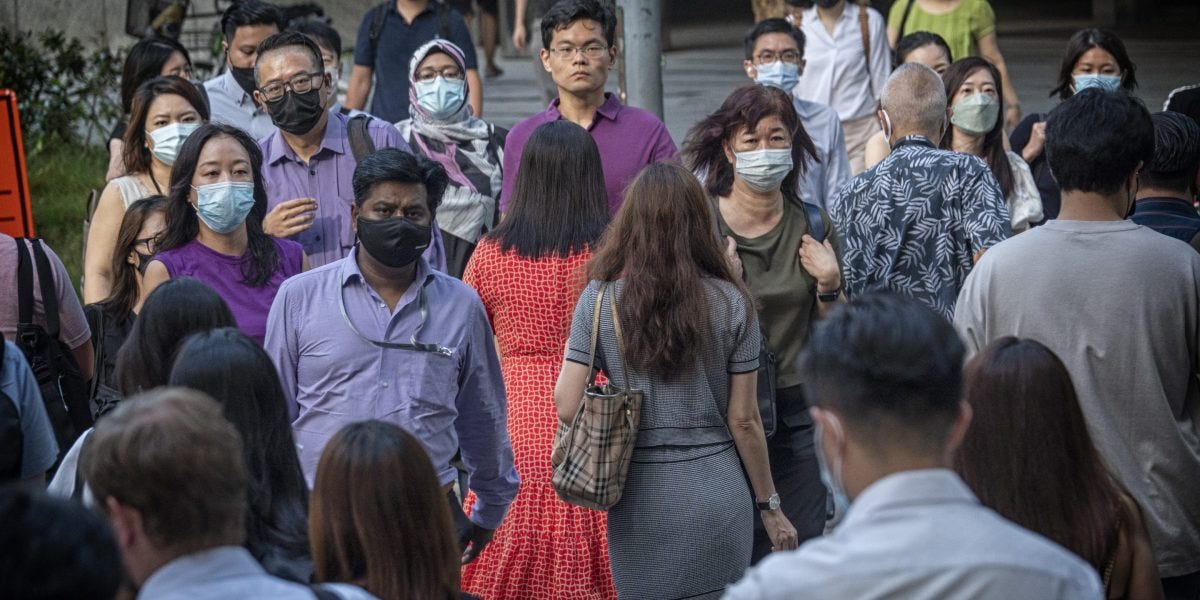Experts are studying the rise of variants like XBB, which combine multiple COVID strains and are driving cases in countries like Singapore.
Forbes
NICHOLAS GORDON
October 11, 2022
Site Editor:
Joaquim Cardoso MSc
Health Transformation Institute (HTI)
October 12, 2022
New variants of the rapidly mutating coronavirus are still popping up around the world, and a new iteration of COVID on the rise in Asia may be the most immune-evasive yet.
The XBB strain is causing a small surge in cases in countries like Bangladesh and Singapore.
The latter has recorded a daily average of about 5,500 cases over the past week, compared to a daily average of 2,000 cases a month ago.
Officials in Singapore, which is scaling back its last remaining COVID restrictions to reopen to the rest of the world, are not yet concerned about the increase in cases.
On Monday, Health Minister Ong Ye Kung noted that only 15% of the country’s recent COVID cases were reinfections.
“If you start to see 50% getting it a second time, you’re going to have a wave,” he said.
The health ministry did start doling out Moderna’s Omicron booster on Tuesday, three days ahead of schedule, citing rising infections caused by the new “XBB Omicron subvariant.”
Hospitalizations in Singapore have increased alongside the rise in cases, yet deaths remain low, with fewer than a dozen recorded in the country over the past week.
Over 90% of Singapore’s population has received two doses of a COVID vaccine, and 79% have received at least one booster.
Bangladesh is also reporting a small uptick in cases, though reported numbers are smaller than Singapore’s.
The South Asian country reported a daily average of about 500 cases during the week of Oct. 3, compared to an average of 300 cases a month earlier. Bangladesh has a vaccination rate of 75.5%.
On Monday, Hong Kong’s health authorities said they found the city’s first case of XBB.1, a subvariant of the XBB strain, in an imported case from the U.S. Officials said the positive case showed no symptoms.
Immune evasive
Experts are paying close attention to the XBB strain, which combines two different Omicron strains.
Eric Topol, founder of the the Scripps Research Translational Institute, tweeted that XBB is one “of the most important variants [to] watch right now.”
Eric Topol, founder of the the Scripps Research Translational Institute, tweeted that XBB is one “of the most important variants [to] watch right now.”
The new strain is “probably the most immune-evasive yet” due to its combination of mutations from other strains, Raj Rajnarayanan, a professor at the New York Institute of Technology’s Jonesboro, Ark., campus, told in September.
A preprint study from Oct. 4, authored by researchers at Peking University and Changping Laboratory, found that XBB had the greatest ability to evade antibody protections among newly emerging variants.
Experts are also concerned that monoclonal antibody treatments might be less effective against newer variants like XBB and BA.2.75.2.
“We’ve not seen this type of immune evasion before,” Michael Osterholm, director of the University of Minnesota’s Center for Infectious Disease Research and Policy (CIDRAP), told earlier this month.
New variants
BA.5 is still the most dominant strain of COVID in the U.S., making up 79.2% of COVID cases recorded between Oct. 2 and Oct. 11, according to the Centers for Disease Control and Prevention’s Nowcast.
But other variants are starting to catch up. Over the past week, 13.6% of cases were from the BA.4.6 subvariant, an increase from 6.4% of cases two months ago.
The BF.7 strain is also spreading quickly, making up 4.6% of cases today compared to just 0.3% two months ago.
In order to keep ahead of the rapidly mutating coronavirus, the U.S. approved bivalent boosters targeting the BA.4 and BA.5 subvariants on Aug. 31.
Yet only 7.6 million Americans have received the Omicron booster since it became widely available on Labor Day.
A survey from the Kaiser Family Foundation found that two-thirds of Americans are either putting off getting the new booster or saying they won’t get it at all.
Originally published at https://fortune.com.
Names mentioned:
CDC
Health Minister Ong Ye Kung
Eric Topol,
Raj Rajnarayanan, a professor at the New York Institute of Technology’s Jonesboro
Michael Osterholm, director of the University of Minnesota’s Center for Infectious Disease Research and Policy (CIDRAP),
Kaiser Family Foundation

Reference Publication:
Imprinted SARS-CoV-2 humoral immunity induces convergent Omicron RBD evolution
BioRxiv
Yunlong Cao, Fanchong Jian, Jing Wang, Yuanling Yu, Weiliang Song, Ayijiang Yisimayi, Jing Wang, Ran An, Na Zhang, Yao Wang, Peng Wang, Lijuan Zhao, Haiyan Sun, Lingling Yu, Sijie Yang, Xiao Niu, Tianhe Xiao, Qingqing Gu, Fei Shao, Xiaohua Hao, Yanli Xu, Ronghua Jin, Youchun Wang, Xiaoliang Sunney Xie
Abstract
- Continuous evolution of Omicron has led to numerous subvariants that exhibit growth advantage over BA.5.
- Such rapid and simultaneous emergence of variants with enormous advantages is unprecedented.
- Despite their rapidly divergent evolutionary courses, mutations on their receptor-binding domain (RBD) converge on several hotspots, including R346, K356, K444, L452, N460K and F486.
- The driving force and destination of such convergent evolution and its impact on humoral immunity established by vaccination and infection remain unclear.
- Here, we demonstrate that these convergent mutations can cause striking evasion of convalescent plasma, including those from BA.5 breakthrough infection, and existing antibody drugs, including Evusheld and Bebtelovimab. BR.2, CA.1, BQ.1.1, BM.1.1.1, and especially XBB, are the most antibody-evasive strain tested, far exceeding BA.5 and approaching SARS-CoV-1 level.
- To delineate the origin of the convergent evolution, we determined the escape mutation profiles and neutralization activity of monoclonal antibodies (mAbs) isolated from BA.2 and BA.5 breakthrough-infection convalescents.
- Importantly, due to humoral immune imprinting, BA.2 and especially BA.5 breakthrough infection caused significant reductions in the epitope diversity of neutralizing antibodies and increased proportion of non-neutralizing mAbs, which in turn concentrated humoral immune pressure and promoted the convergent RBD evolution.
- Additionally, the precise convergent RBD mutations and evolution trends of BA.2.75/BA.5 subvariants could be inferred by integrating the neutralization-weighted DMS profiles of mAbs from various immune histories (3051 mAbs in total).
- Moreover, we demonstrated that as few as five additional convergent mutations based on BA.5 or BA.2.75 could completely evade most plasma samples, including those from BA.5 breakthrough infection, while retaining sufficient hACE2-binding affinity.
- These results suggest that current herd immunity and BA.5 vaccine boosters may not provide sufficiently broad protection against infection.
- Broad-spectrum SARS-CoV-2 vaccines and NAb drugs development should be of high priority, and the constructed convergent mutants could serve to examine their effectiveness in advance.












